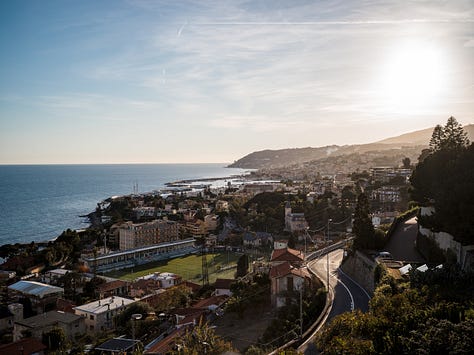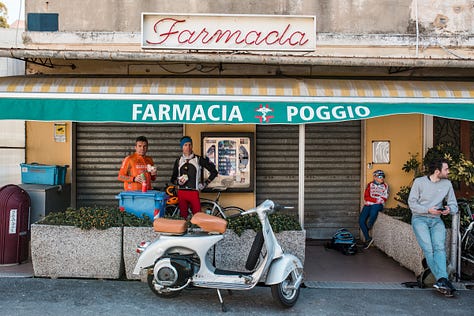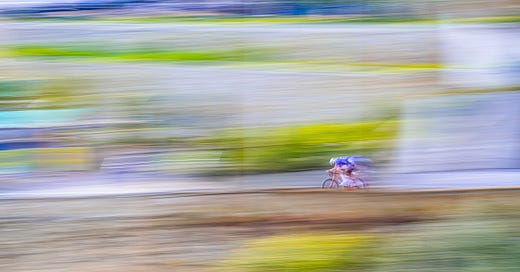by Lionel Birnie
As we drove to Sanremo, Simon and I talked about our plan for race day. As we’d be in a vehicle, we’d probably only be able to see the race once, I said.
The photographers on motorbikes, with their golden ticket access, have no such worries. They can accompany the peloton all the way, taking turns to get up close to the riders to get their shots. But we would be in The Cycling Podcast’s Broomwagon, reducing our opportunities.
I could tell Simon was sceptical. He’s photographed races all over Europe and is used to criss-crossing the countryside to catch the riders at several points. Even at the Tour de France, where the crowds are big and the race bubble tight, it is usually possible to see them twice or three times en route and still make it to the finish line.
But Milan-Sanremo is different. Once the riders reach the Ligurian coast, the course travels in a straight line. Even though there’s a motorway that runs parallel to the Via Aurelia which the riders take, the distances between the three capi, the Cipressa and the Poggio are too short and the speeds too high for us to zip between them. The forecast tailwind reduced our chances of seeing the riders more than once even further.
All of a sudden, driving almost fifteen hundred kilometres for a fleeting glimpse of the race seemed like a bad deal for Simon, I expect.
When we rode the final 100 kilometres (okay, 98.6 kilometres) a couple of days before the race, Simon appreciated the lie of the land and accepted that trying to be more ambitious was too much of a risk. We could, in theory, have driven to somewhere between Savona and Spotorno and still made it to the Poggio but I wanted to record material for our podcast with Herbie Sykes and didn’t want to jeopardise our chances of getting there in good time.
Driving fifteen hundred kilometres to see the race once was better than driving fifteen hundred kilometres and missing it entirely, was my reasoning.
‘How about you do something like A Portrait of the Poggio? Photograph the climb, the people and the place as the day unfolds. Capture the sense of waiting and the anticipation and then shoot the race when it comes past,’ I said.









‘If you’re only going to take one photograph of the race, make sure it’s a good one.’
We headed up to the Poggio early, arriving about five hours before the riders were due. Simon set off to scout locations. He decided to walk down the hill to shoot the riders on the descent. It was a smart move because even the photographers on motorbikes struggle with that. Many of them hope to capture the decisive moment on the climb of the Poggio and then speed ahead to get down to the finish line in the Via Roma in time to see the winner cross the line. In fact, this year, the organisers had agreed, apparently at the UCI’s suggestion, to ensure no motorbikes would be buzzing around the riders on the descent, not even the TV broadcaster’s bikes. Last year Michael Matthews was one of the riders who complained that motos were too close to Matej Mohorič and claimed that they helped drag him away from the chasers.
Panning for gold
A photo taken on the descent would have rarity value, if nothing else. However, what Simon produced was remarkable. Shot of the day, to my eye anyway, not just because of the result of the eye-catching panning technique he used, but because it tells the story of the race in one image. Mathieu van der Poel alone, speeding down the Poggio, on his way to victory.
Simon picks up the story. ‘On my way down the Poggio, a group of lads enjoying a few beers in the sunshine asked me to take their photo and gave me a small beer as a thank you. I sipped it as I walked down the hill and when I popped out of a small pathway that cut between the sweeping bends and looked across at the road, I knew I had my spot.
I can be quite indecisive and rarely think, ‘Yes, this is definitely the spot,’ because I always worry there’ll be a better place just round the corner.
During this brief rush of decisiveness and confidence I also decided to use a panning technique that can produce really effective results. The downside is that it can be quite sporadic and even with a steady hand and several attempts you can end up with not a lot to show for your efforts. But I decided the risk was worth it.
I practiced the technique on some vehicles as they passed ahead of the race. Even though I was constantly fiddling with the f-stop and shutter speeds I wasn’t getting the result I wanted, even with the pressure off.
Before I knew it the helicopters were overhead and the race was upon me. I was committed, so I took a deep breath and followed Van der Poel with my lens as steadily and smoothly as I could, panning from right to left as he descended.
Click. Pause. Click. Pause. Click. The shutter speed was so slow and the rider so fast I only got three goes at it.
When the race had passed and I had chance to look at my shots I hoped for the best. The first one was okay but nothing special. The second was better but not quite right. Then the final one turned out to be a nice example of this technique when it works well. Phew’ – Simon Gill
It’s a photograph that demonstrates how many elements have to fall into place to make the perfect shot.
If Van der Poel had been with two or three other riders it would still have been a stunning picture but it wouldn’t have been quite the same. If he’d been caught on the run-in and someone else had won the race, the photo would have lost a lot of its importance because it wouldn’t have been of the winner. The extra bit of magic – the story behind it and the significance of the moment – would have faded a little.
As it is, everything about the shot is perfect. The angle of Van der Poel’s head, the position of his foot nearest the camera, the extent to which the blur conveys speed but leaves most of his body and bike still visible, all matters. The other frames in this sequence are good but they’re not the one. This one had us punching the air. Actually, Simon’s not the sort to punch the air over his own work, so I did on his behalf.
If you’d like to support Simon’s work, his photo is available as a print now.
Our Milan-Sanremo Friends of the Podcast special will be out soon-ish.









Arrivée returns for the Spring Classics
Arrivée – our post-race reaction show – returned for Milan-Sanremo and will be back with episodes for the men’s and women’s Tour of Flanders, Paris-Roubaix and Liège-Bastogne-Liège in April. The March episode of The Cycling Podcast Féminin will be online very shortly too, with Rose, Orla and Lizzy recapping all the recent racing.
The Tour d’Écosse at the Sports Podcast Awards
There’s still time to vote for our Tour d’Écosse series in the Sports Podcast Awards. Voting closes on April 6. We’ve received so many positive comments over the past few months. Thank you to everyone who has written to us or left a comment on social media. Here’s one example ‘I am enjoying the Tour d’Écosse more than I can say. I want it to go on and on. I listened to stage five, part one today and it (and the series) blows me away. It is, in turns, romantic, whimsical, engaging, surprising and beautiful. I laugh (spoons, dogs) and cry every episode’ – Cathy Johnson
From the archive: The Lionel of Flanders




Now the focus shifts to Flanders and the cobbled classics. An intense ten-day period will see the E3 Saxo Classic, Gent-Wevelgem and Dwars Door Vlaanderen lead to the big one, the Tour of Flanders, a week on Sunday.
In 2017, Simon and I travelled to the region to see the three one-day races that build the excitement and anticipation. The resulting five-part Lionel of Flanders series – which owes its title to our producer Tom Whalley – has been one of our most popular for Friends of the Podcast and we know people like to revisit it to whet the appetite for the races to come.
Looking at Simon’s photos from that week I’m struck by how ‘old’ cycling looks, even though it’s only six years ago. The jerseys are tight but they are not the spray-on style skinsuits we see today; the designs have dated too; the bikes have rim brakes and Tom Boonen was still racing – although he would retire a couple of weeks later in the velodrome in Roubaix.
And yet so much about the races and the Flemish cycling culture remains the same, unchanged by the passing of years.
Day 1 – We went to watch Dwars Door Vlaanderen and discovered why Zulte Waregem’s football stadium is named after cycling’s rainbow jersey
Day 2 – We cycled to the André Pétrieux velodrome in Roubaix via one of the most notorious roads in cycling history, the Rue du Dronckaert
Day 3 – We spent the day watching the GP E3 Harelbeke, also known as the Little Tour of Flanders
Day 4 – Literary Flanders. We met up with two authors who’ve written about the region’s cycling culture, Harry Pearson and Edward Pickering
Day 5 – We headed to the Kemmelberg, for so long a feature of Gent-Wevelgem, and a relatively new addition, the Plugsteets, gravelled farm tracks in the battlefields that saw so much conflict during World War One
MAAP x The Cycling Podcast
I’m an unlikely model for a cycling jersey but if our MAAP jersey looks this good on me, imagine how good it’ll look on you! Here I am on the beach at Laigueglia, contemplating some sandy cyclo-cross with my socks outside my legwarmers like a pro.





